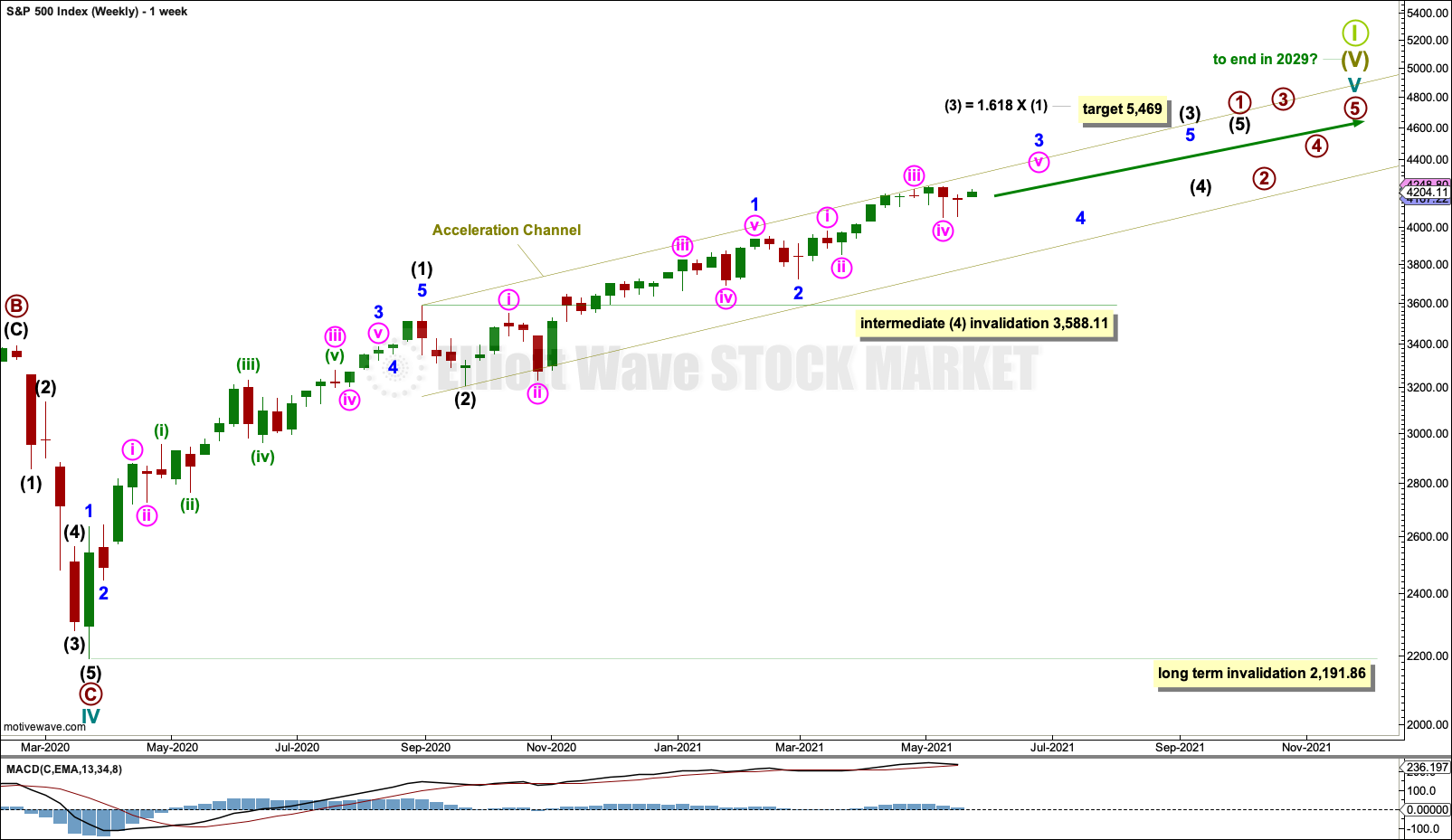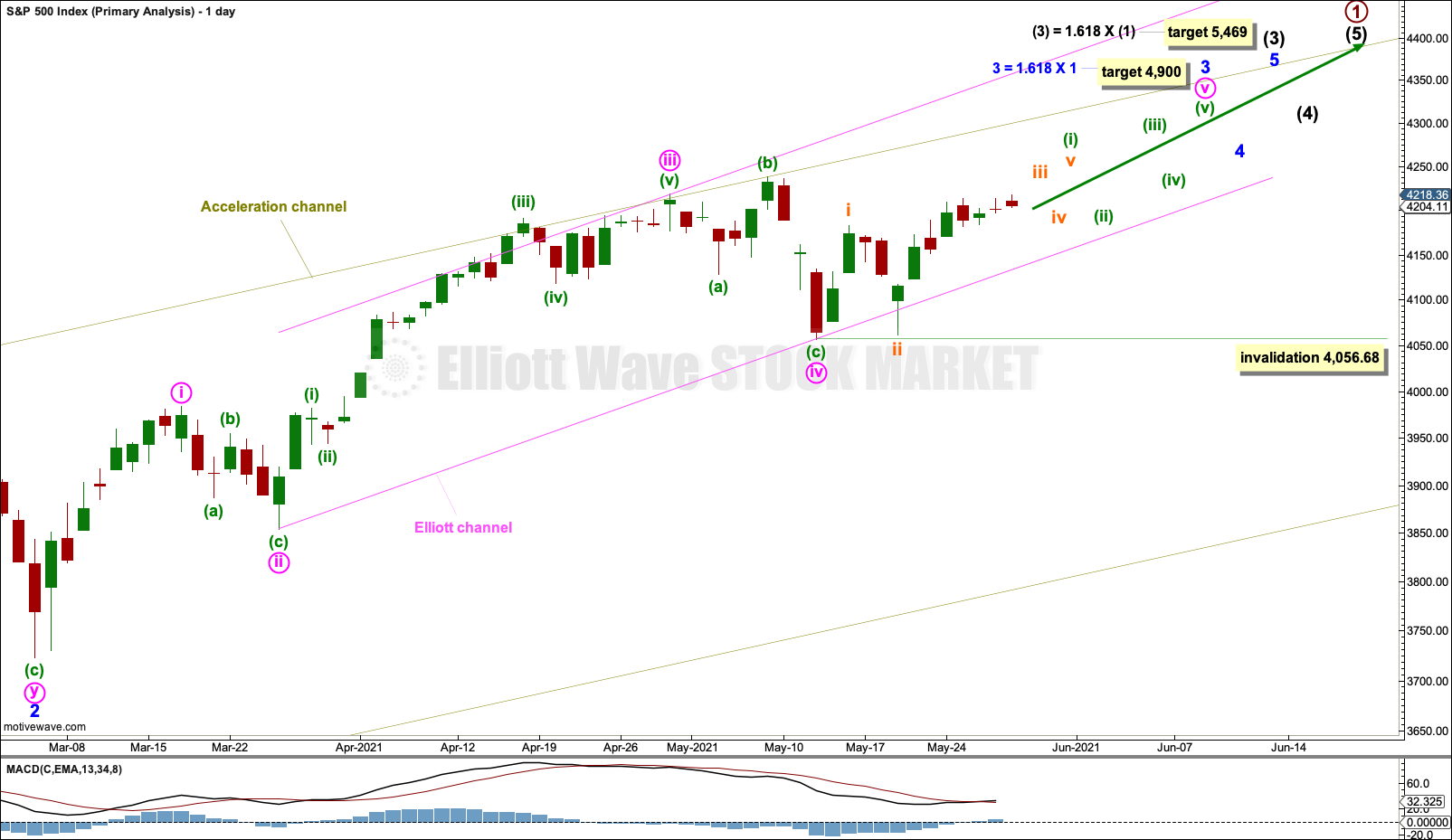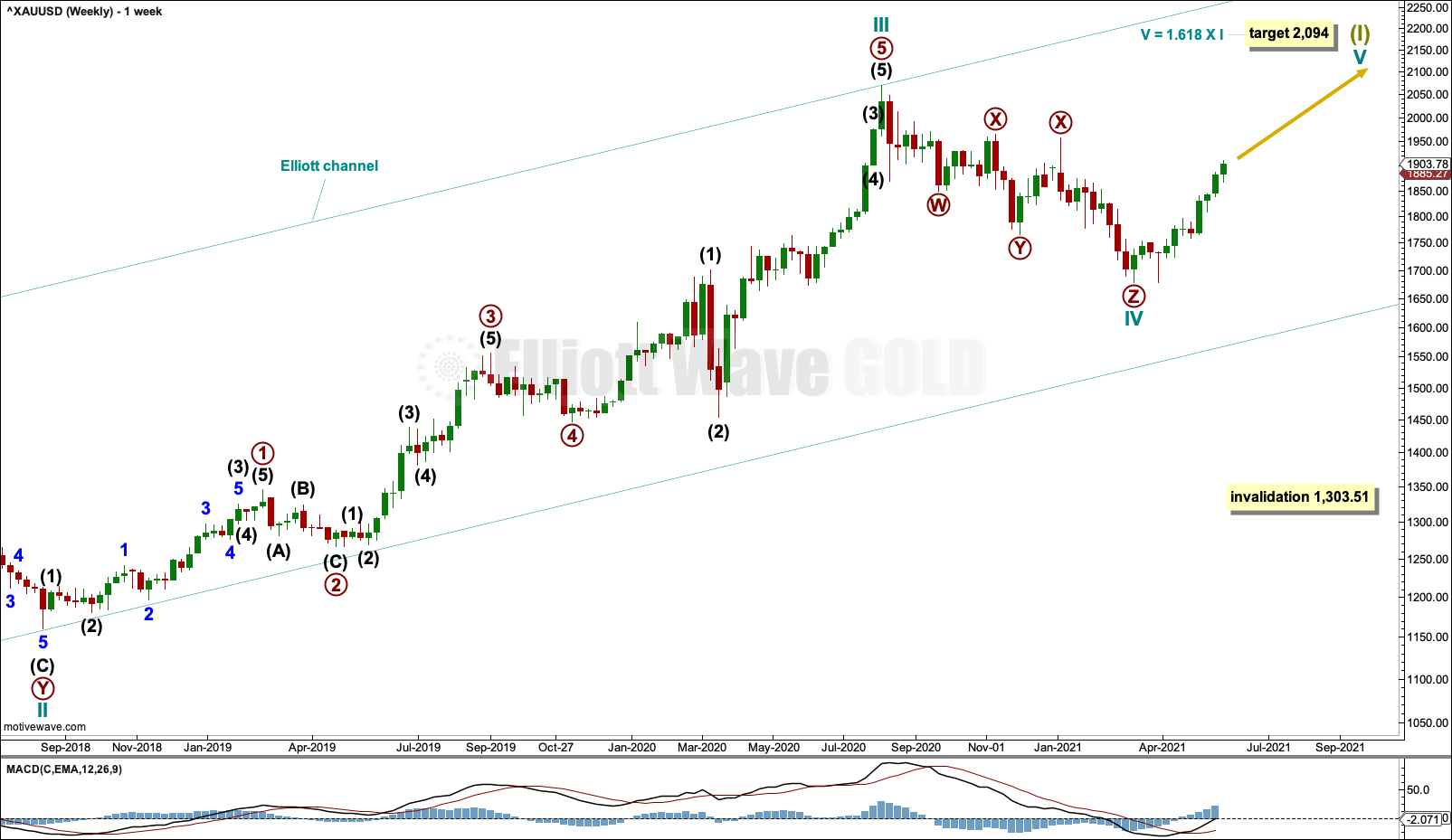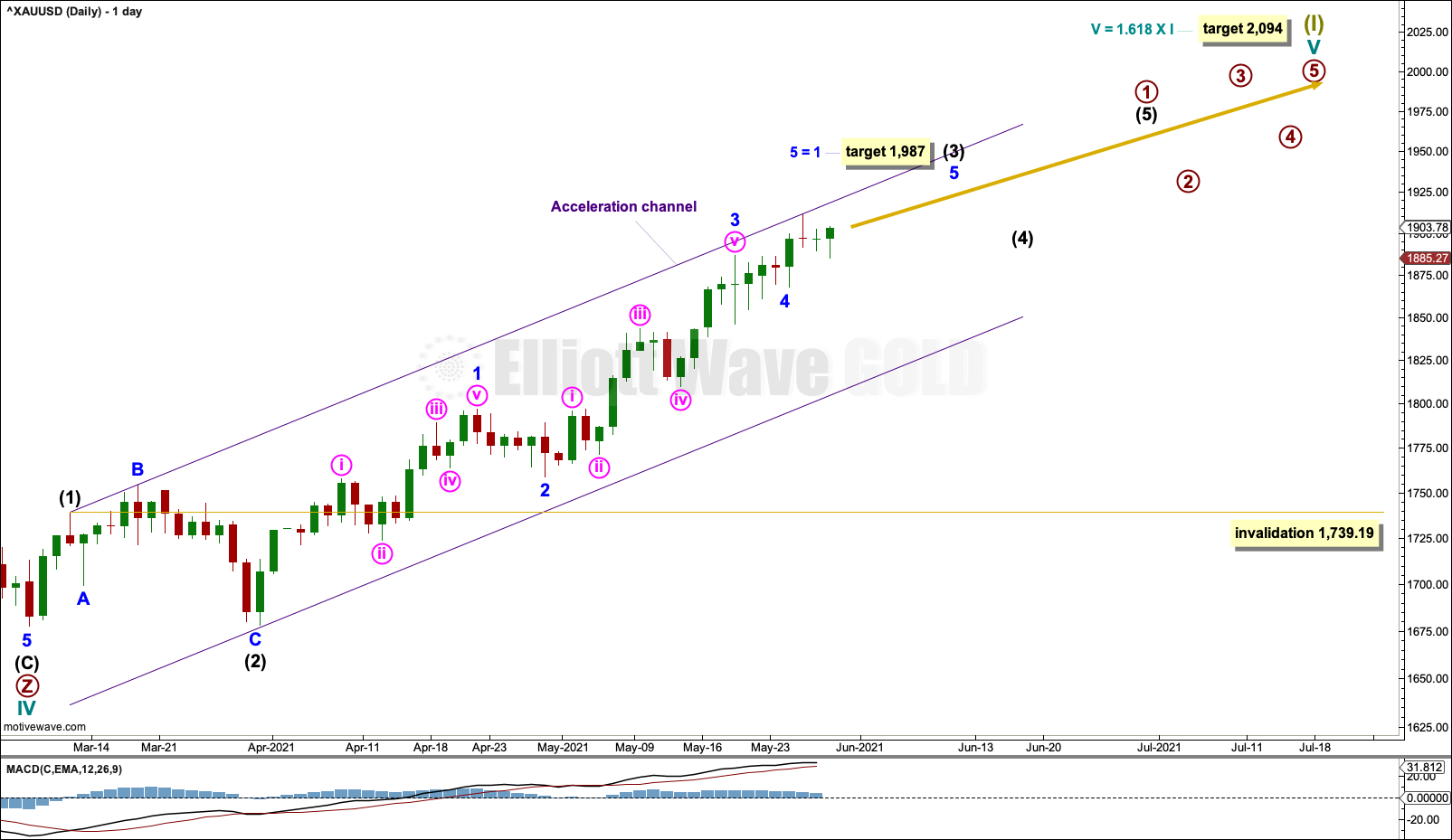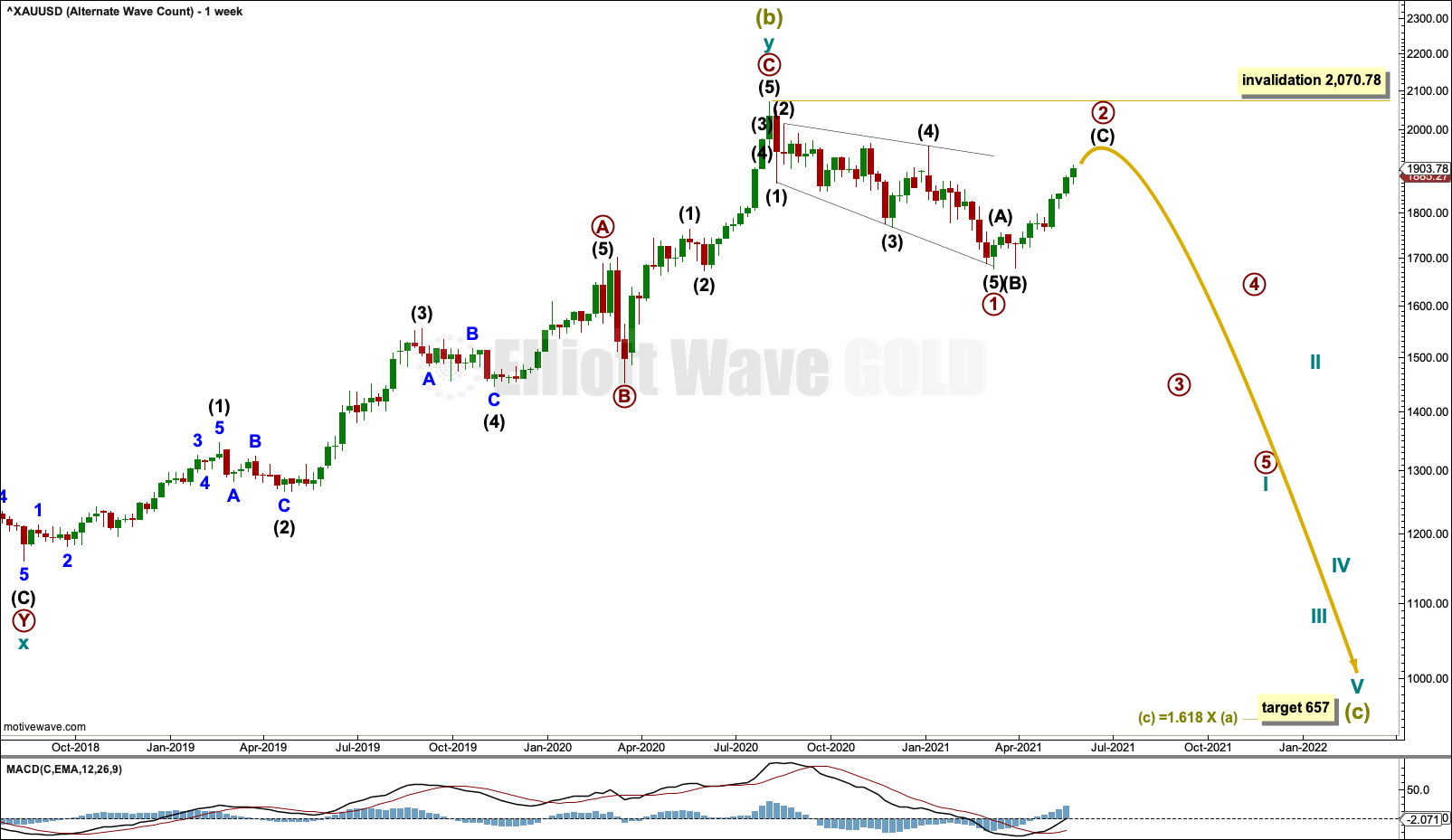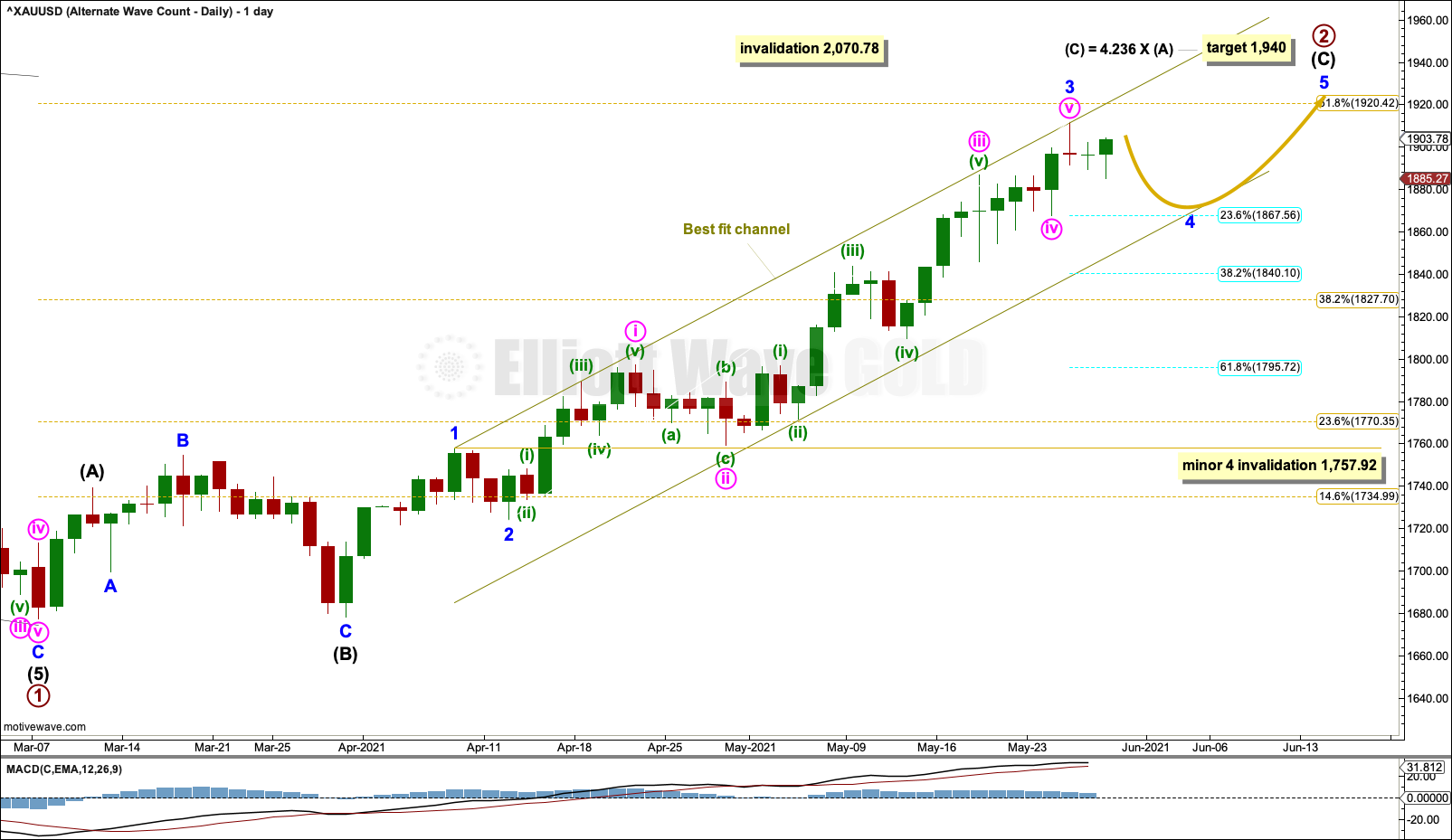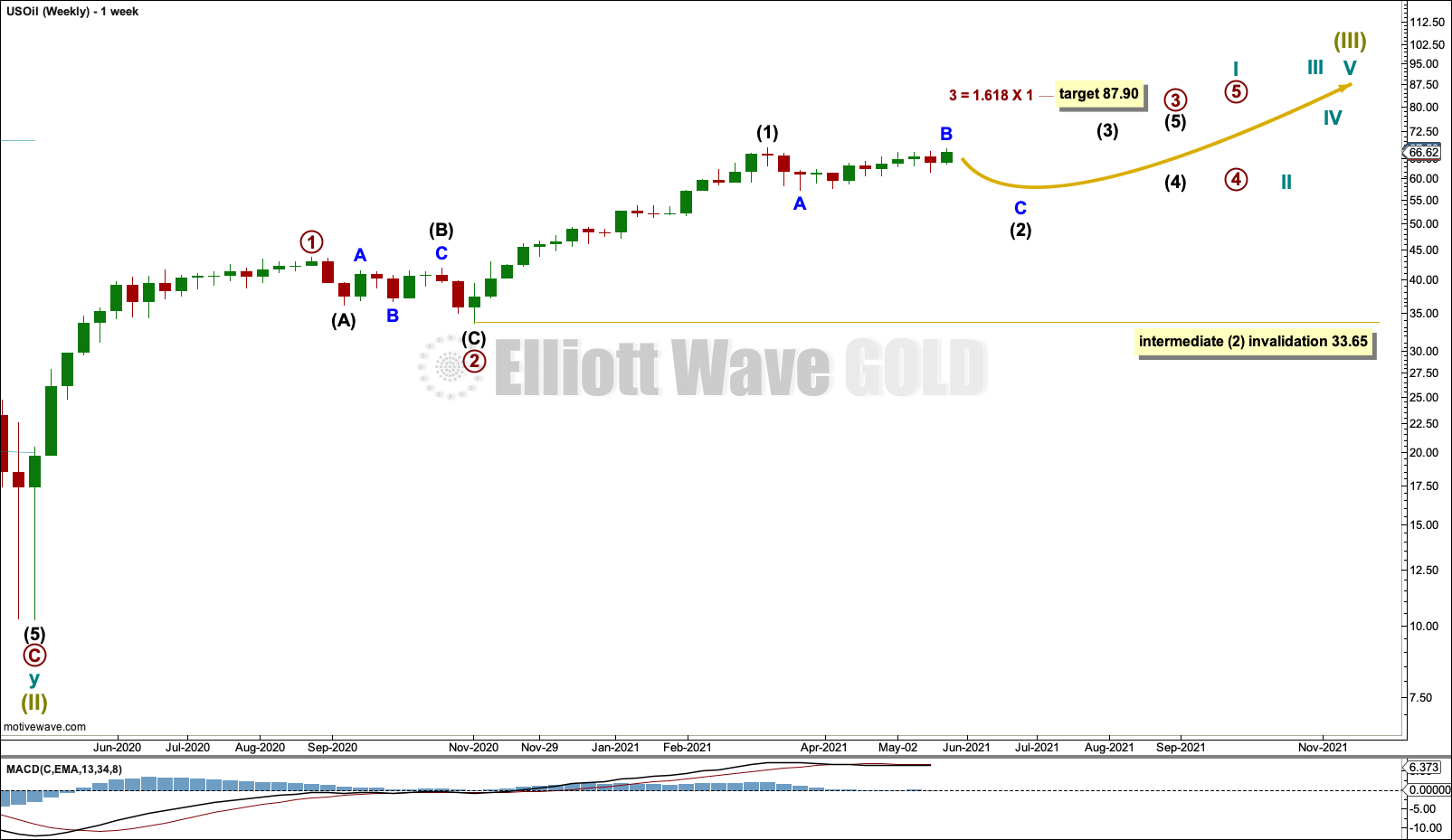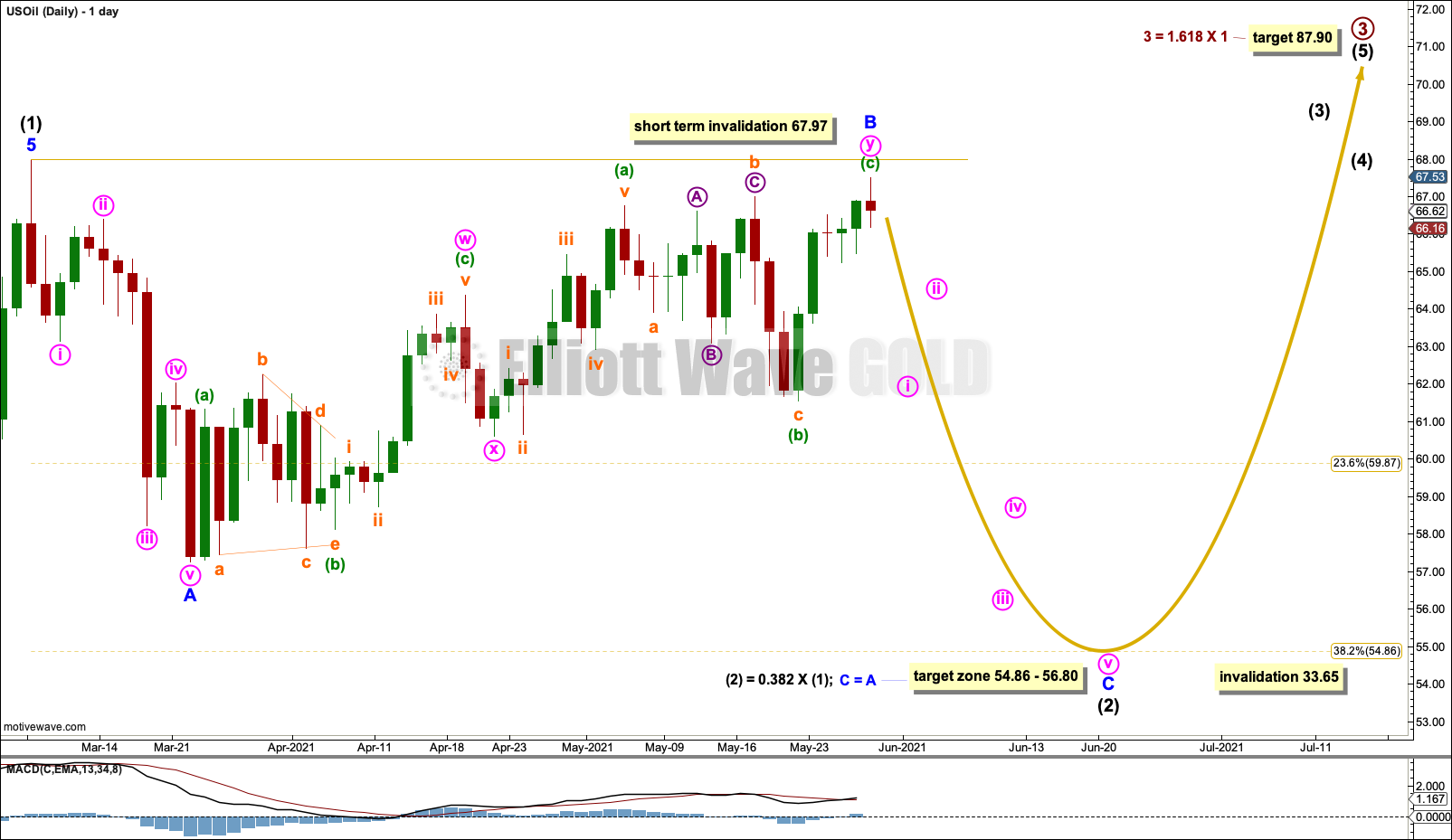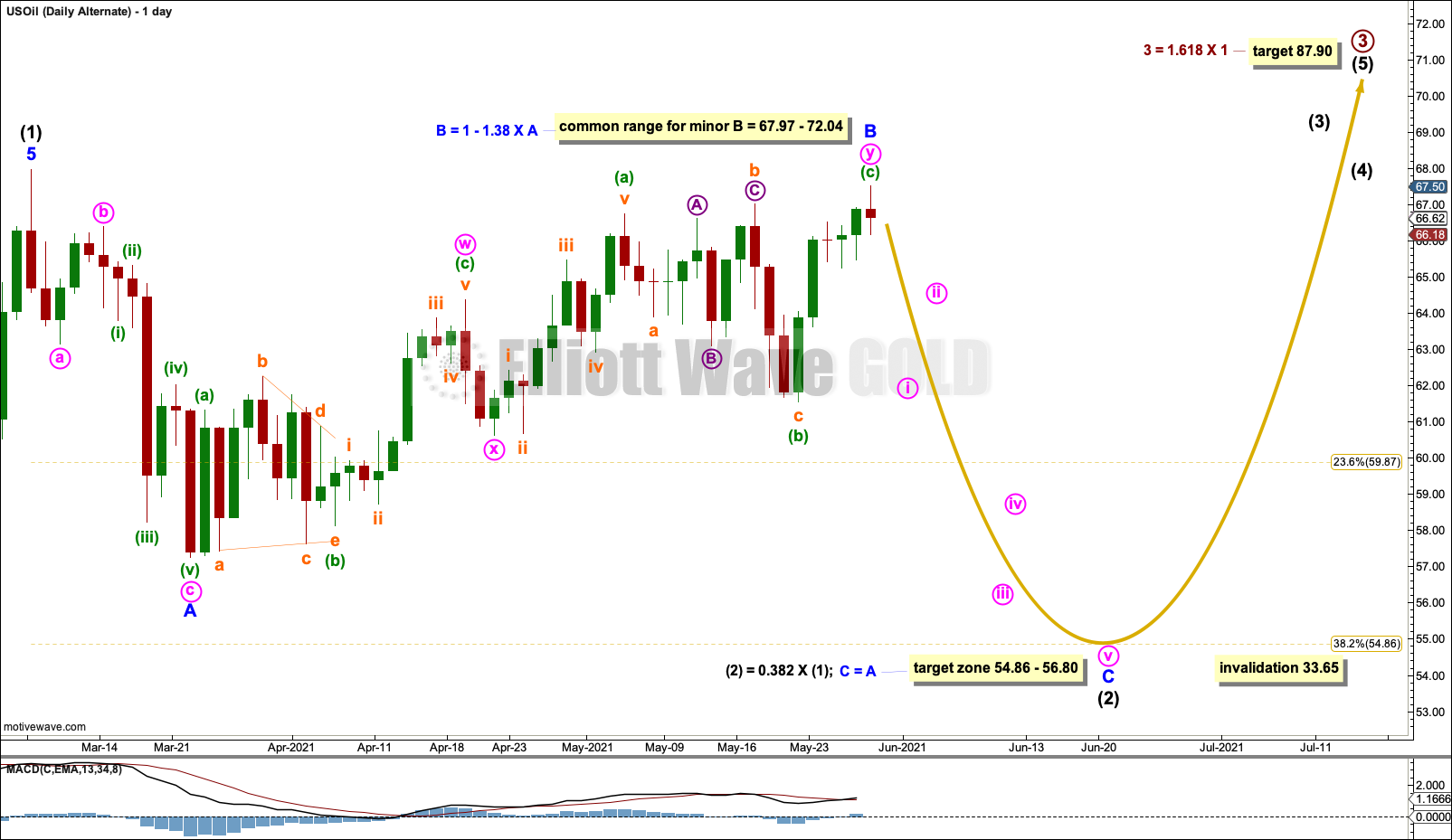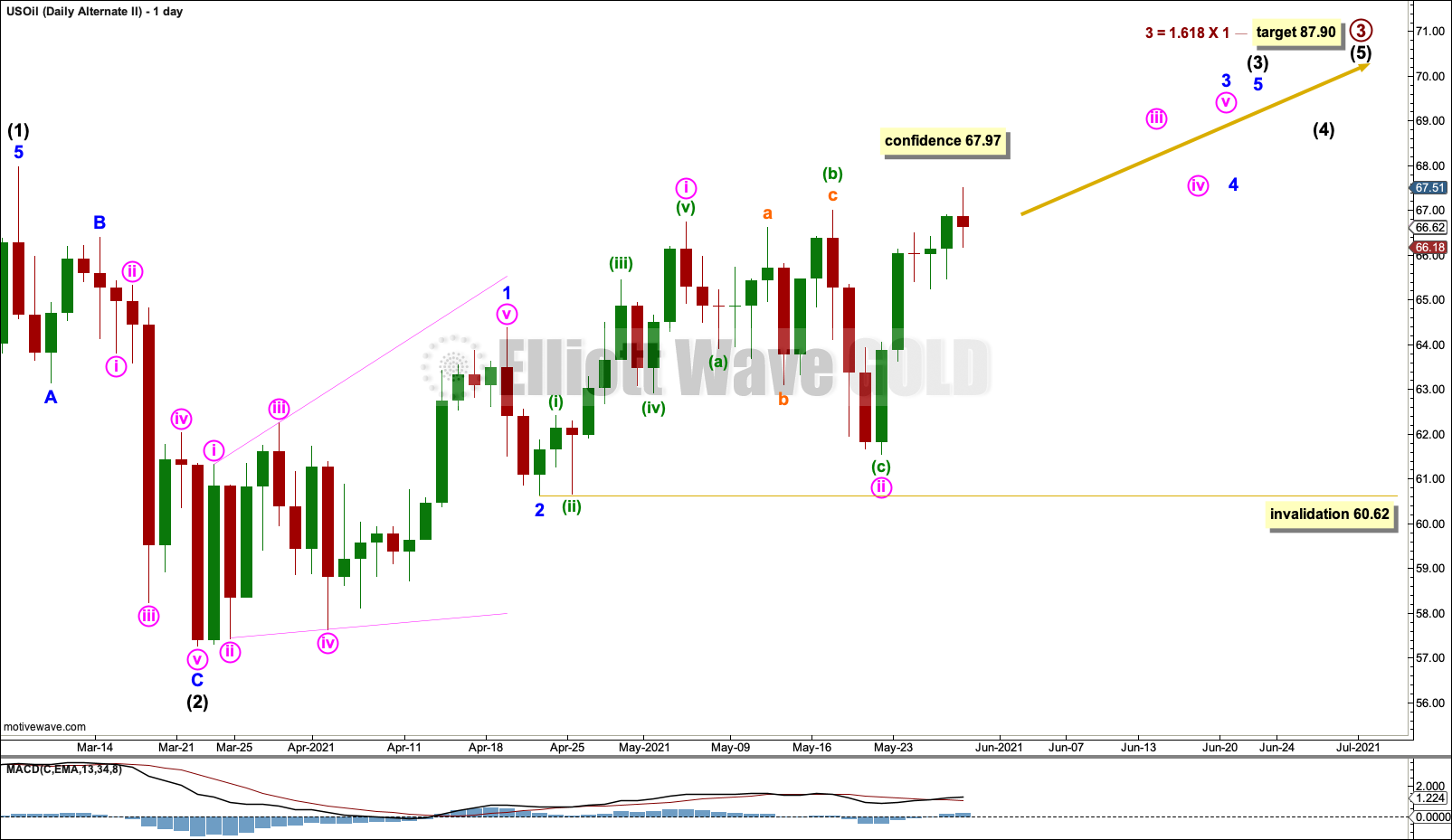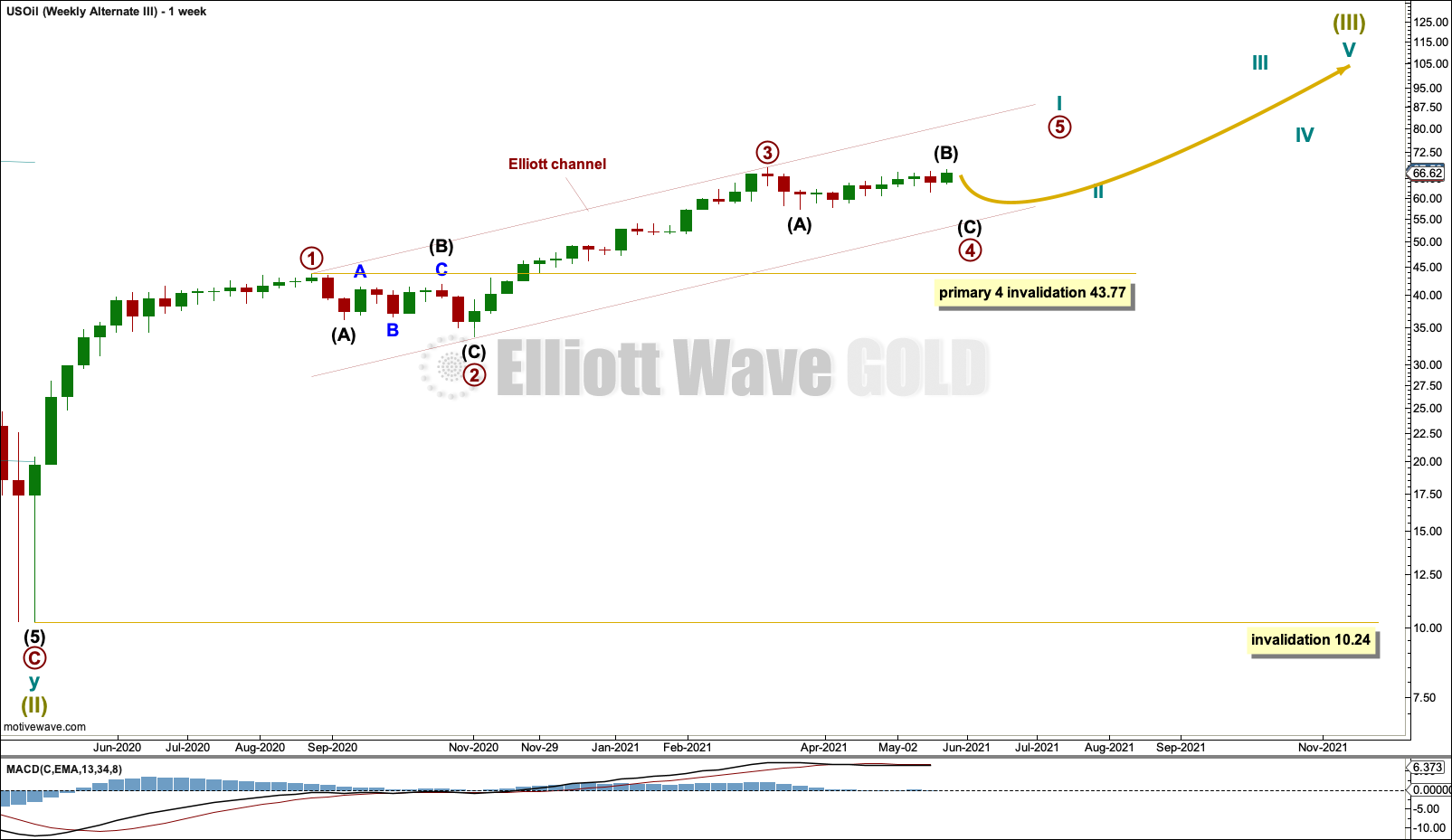Lara’s Weekly: Elliott Wave and Technical Analysis of S&P500 and Gold and US Oil | Charts – May 28, 2021

S&P 500
Last week’s analysis expected upwards movement overall to continue, and it has. Although this week failed to make a new all time high, price has moved higher and closed green with a slight increase in volume.
Summary: The trend is up. The next target for the next wave up is at 4,900.
For the short term, price has been consolidating for four weeks with resistance at 4,238 and support at 4,058. While price remains above 4,182.52, it would be most likely that an upwards breakout from the consolidation may occur soon.
A new low below 4,182.52 though may indicate another downwards swing within the consolidation, which may end about either 4,177 or 4,155.
The biggest picture, Grand Super Cycle analysis, is here.
Last monthly charts are here. Video is here.
ELLIOTT WAVE COUNT
WEEKLY CHART
Cycle wave V may last from one to several years. So far it is in its fourteenth month.
This wave count may allow time for the AD line to diverge from price as price makes final highs before the end of the bull market. The AD line most commonly diverges a minimum of 4 months prior to the end of a bull market. A longer divergence is positively correlated with a deeper bear market. A shorter divergence is positively correlated with a more shallow bear market. With zero divergence at this stage, if a surprise bear market does develop here, then it would likely be shallow.
A longer divergence between price and the AD line would be expected towards the end of Grand Super Cycle wave I.
It is possible that cycle wave V may continue until 2029, if the 2020s mirror the 1920s. Either March or October 2029 may be likely months for the bull market to end.
Cycle wave V would most likely subdivide as an impulse. But if overlapping develops, then an ending diagonal should be considered. This chart considers the more common impulse.
There is already a Fibonacci ratio between cycle waves I and III within Super Cycle wave (V). The S&P500 often exhibits a Fibonacci ratio between two of its actionary waves but rarely between all three; it is less likely that cycle wave V would exhibit a Fibonacci ratio. The target for Super Cycle wave (V) to end would best be calculated at primary degree, but that cannot be done until all of primary waves 1, 2, 3 and 4 are complete.
Primary wave 1 within cycle wave V may be incomplete. This gives a very bullish wave count, expecting a long duration for cycle wave V which has not yet passed its middle strongest portion.
Within primary wave 1: Intermediate waves (1) and (2) may be complete, and intermediate wave (3) may now be nearing an end.
Within intermediate wave (3): Minor waves 1 and 2 may be complete, and minor wave 3 may be nearing an end.
Intermediate wave (4) may not move into intermediate wave (1) price territory below 3,588.11.
An acceleration channel is drawn about cycle wave V. Draw the first trend line from the end of intermediate wave (1) to the last high, then place a parallel copy on the end of intermediate wave (2). Keep redrawing the channel as price continues higher. When primary wave 1 is complete, then this channel would be drawn using Elliott’s first technique. The channel may then be used to provide confidence that primary wave 1 may be over and primary wave 2 may have arrived; when the channel is breached by downwards movement it would indicate a trend change.
When primary wave 1 may be complete, then a multi-month pullback or consolidation may unfold for primary wave 2. It is possible that primary wave 2 may meet the technical definition of a bear market; it may correct to 20% or more of market value.
Primary wave 2 may not move beyond the start of primary wave 1 below 2,191.86.
DAILY CHART
The daily chart focusses on minor wave 3 within intermediate wave (3).
Intermediate wave (3) may be extending. Third waves are most commonly extended for the S&P500, so this wave count follows a common tendency. A target is calculated for minor wave 3, which is also expected to be extending.
No second wave correction within minute wave v may move beyond its start below 4,056.68.
Now that minute wave iv may be complete, as it overshot a channel drawn using Elliott’s first technique, redraw the channel now using Elliott’s second technique. Draw the first trend line from the ends of minute waves ii to iv, then place a parallel copy on the end of minute wave iii. This redrawn channel may show where minute wave v may end, either mid way within the channel or about the upper edge. It may then be used to confirm a subsequent trend change, when it is breached by downwards movement.
The channel is overshot, which for this market is acceptable, and price has moved back within the channel. This market does not always sit neatly within channels as its impulses come to an end. It is possible that as minor wave 3 ends channels may need to be redrawn.
TECHNICAL ANALYSIS
MONTHLY CHART
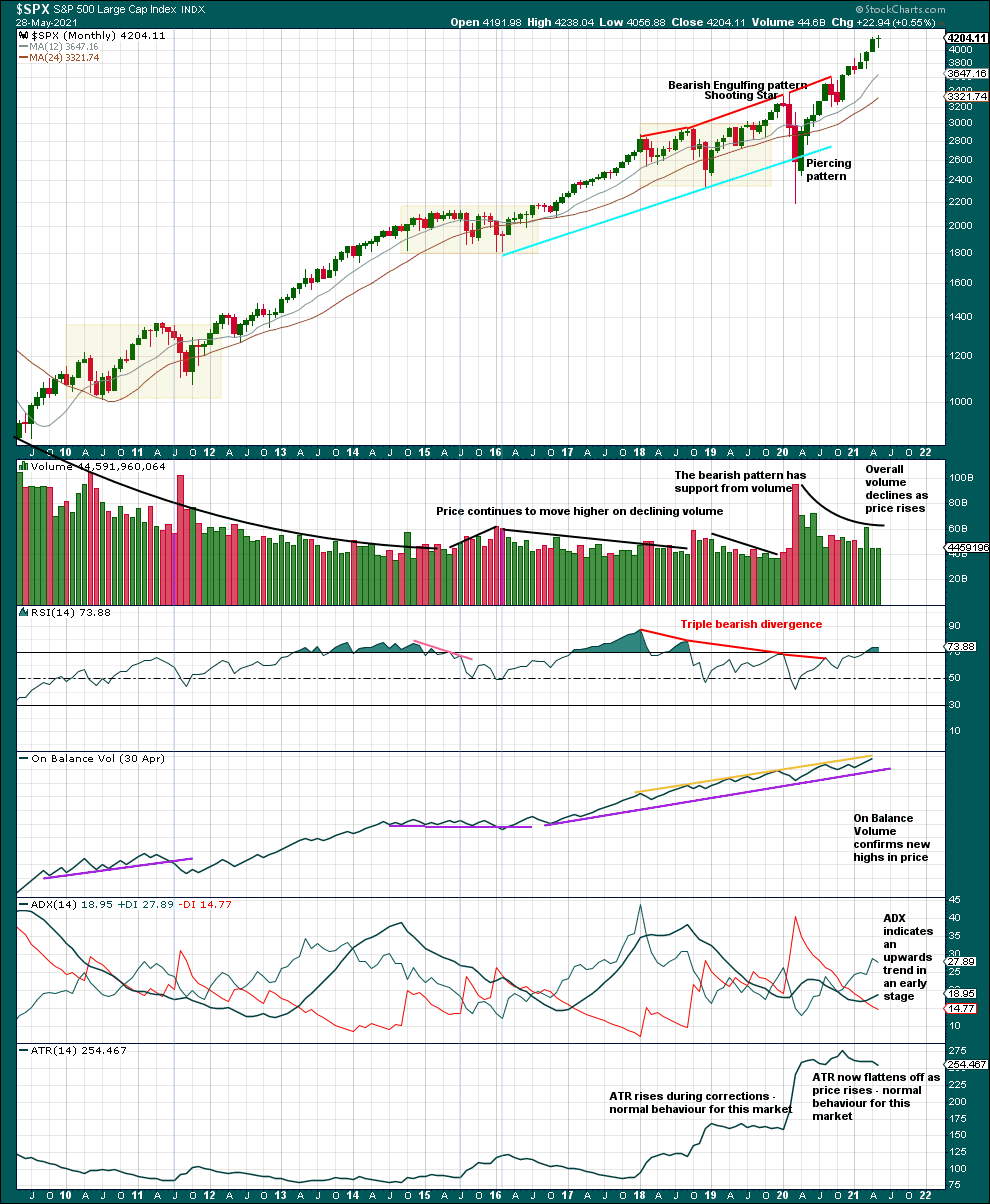
Click chart to enlarge. Chart courtesy of StockCharts.com.
With the NYSE closed on Monday the 31st of May for Memorial Day, Friday is the last trading day of May for the S&P500.
May 2021 monthly candlestick closes as a small green doji. This on its own is not a bearish candlestick reversal pattern. This represents a pause, a balance of bulls and bears. There are six other monthly candlesticks on this chart that closed as doji within the context of an upwards trend; these are circled in yellow on the chart. Two of the six examples come near important highs, whereas the other four are either close to lows or within the body of the trend. This is pointed out here to illustrate that this month’s doji is not necessarily bearish, and that there is precedent in this chart where it has occurred before and was not a bearish signal.
Strong triple bearish divergence up to September 2020 led to only a very small pullback, before the upwards trend resumed. This is a good example of how divergence even when strong and over a reasonable period of time does not always lead to a bear market.
ADX is bullish. RSI is just recently overbought, but this may become more extreme and remain so for a long time. This market has a strong bullish bias.
WEEKLY CHART

Click chart to enlarge. Chart courtesy of StockCharts.com.
A series of higher highs and higher lows off the low of March 2020 continues. The last short-term swing low is now at 3,723.34. While this remains intact, the dominant view should be of an upwards trend. There is a long way for this trend to run before conditions may become extreme.
This chart has the look of a sustainable bull market in a relatively early stage; there is as yet no evidence that a larger correction should begin here. Although RSI very recently reached overbought, this market has a strong bullish bias and RSI can move deeply overbought and remain there for years prior to the bull market ending.
Now two long lower wicks on two weekly candlesticks are bullish for the short term.
For the short term, price looks to be in a small consolidation with support about 4,057 and resistance at the last all time high about 4,238. With the larger trend upwards, it would be most likely this consolidation may resolve with an upwards breakout.
DAILY CHART
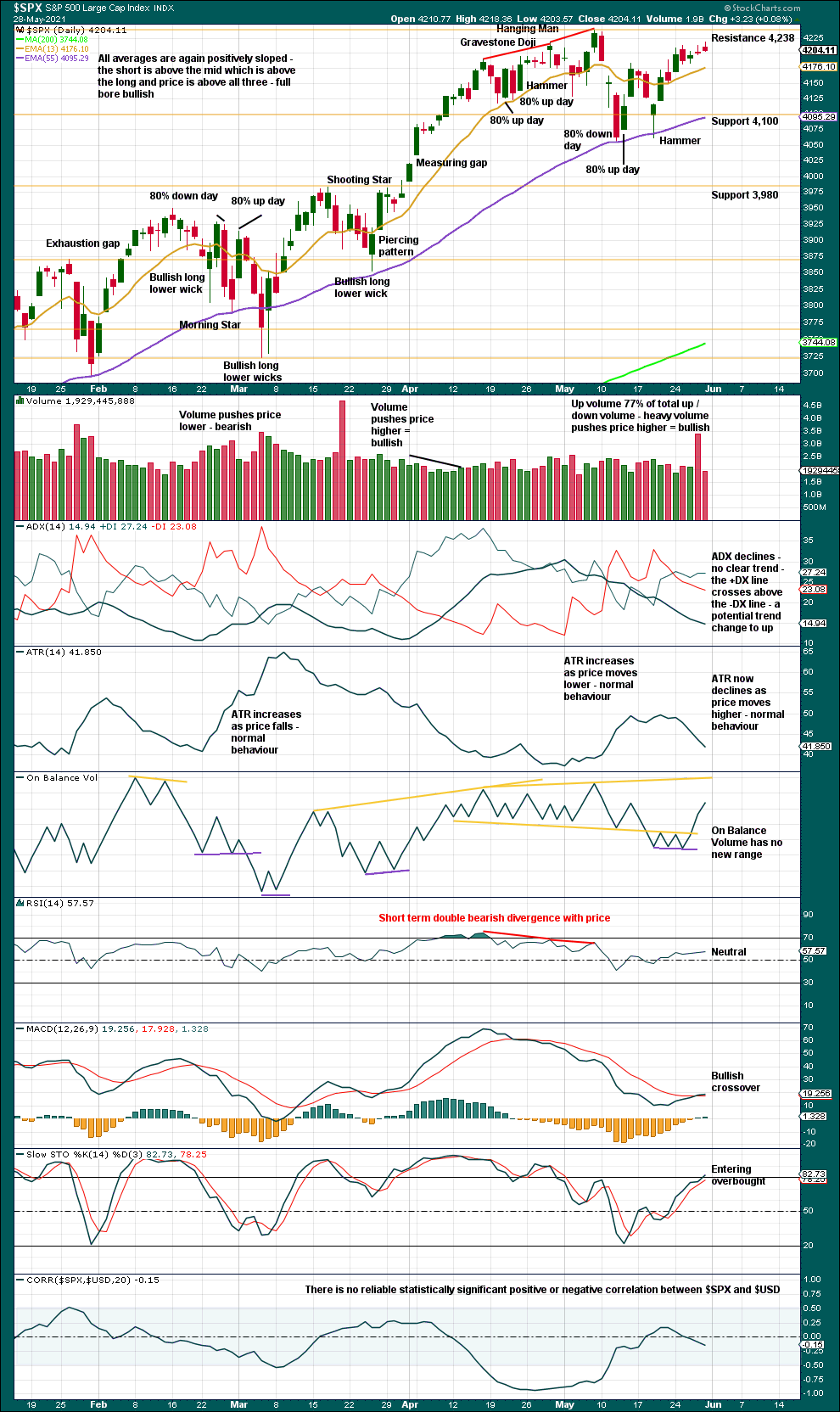
Click chart to enlarge. Chart courtesy of StockCharts.com.
The series of higher highs and higher lows from the low of the 30th of October continues.
Pullbacks and consolidations are a normal and to be expected part of a bullish trend.
If the consolidation continues, then a downwards swing within it may develop about here. A close above resistance at 4,238.04 would constitute an upwards breakout from the consolidation; if that happens, then upwards momentum may show some increase.
BREADTH – AD LINE
WEEKLY CHART
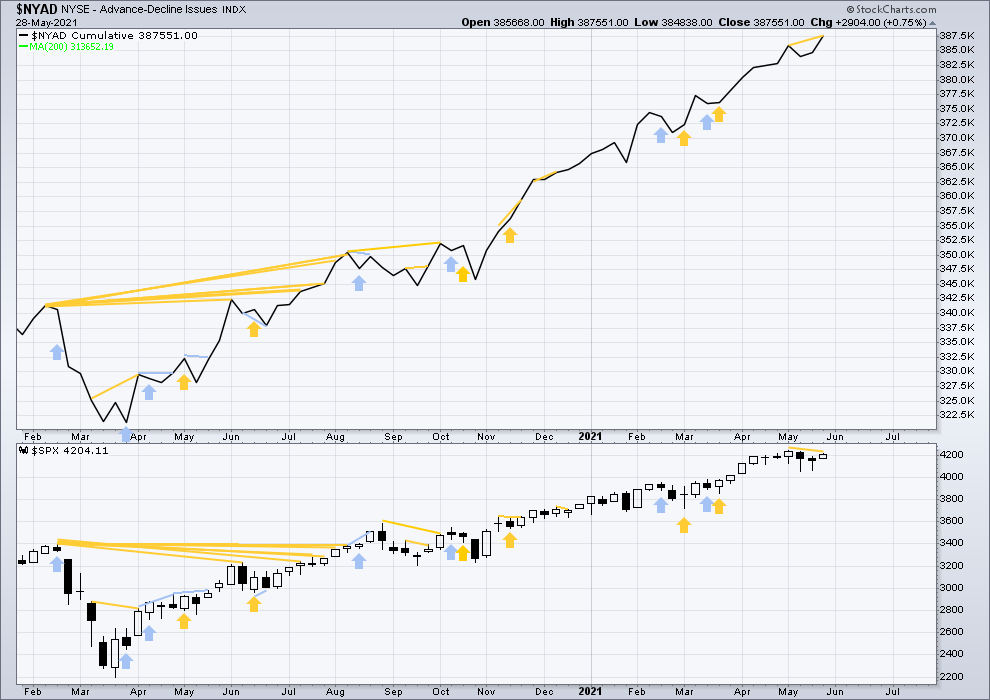
Click chart to enlarge. Chart courtesy of StockCharts.com. So that colour blind members are included, bearish signals will be noted with blue and bullish signals with yellow.
Breadth should be read as a leading indicator.
Lowry’s Operating Companies Only AD line has made a new all time high on the 27th of May. This supports the Elliott wave counts.
Large caps all time high: 4,238.04 on May 7, 2021.
Mid caps all time high: 2,778.84 on April 29, 2021.
Small caps all time high: 1,399.31 on March 12, 2021.
The last new high is found in large caps only. Small caps have been lagging since the 15th of March. Mid caps have been lagging since the 29th of April. This lag from small and mid caps is not precise in terms of timing when a pullback may begin, but it is an early warning sign of some developing weakness. It would be expected that as third waves come to an end some weakness should begin to develop; this situation may fit with the Elliott wave count.
This week the AD line has made a new all time high, but price has not. This is a strong bullish signal and supports the Elliott wave count.
DAILY CHART
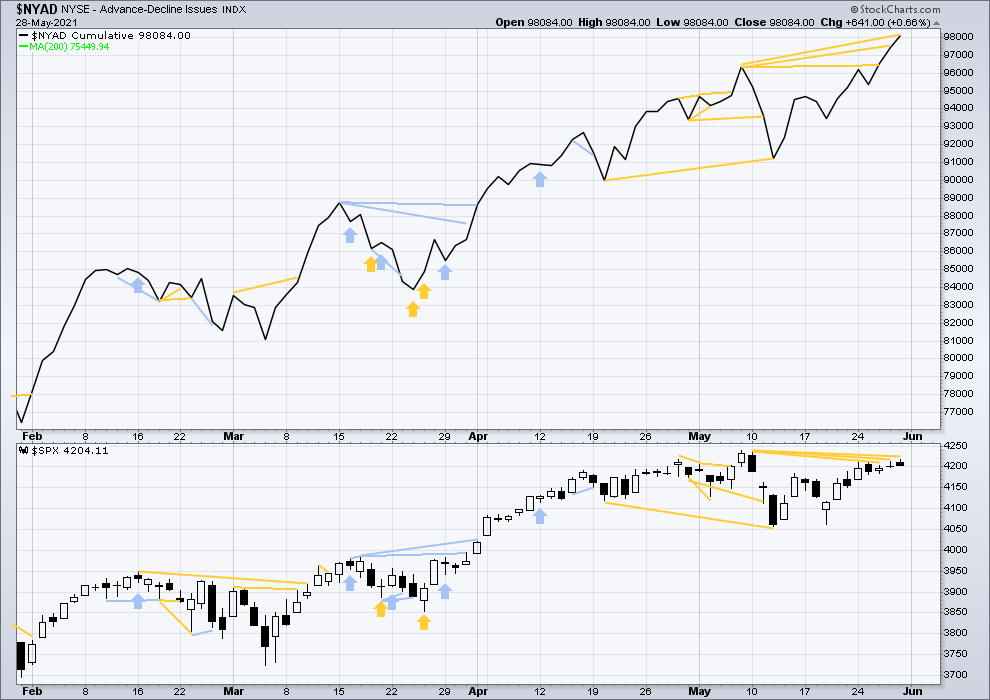
Click chart to enlarge. Chart courtesy of StockCharts.com. So that colour blind members are included, bearish signals will be noted with blue and bullish signals with yellow.
The NYSE all issues AD line has for the third day in a row made a new all time high. This is bullish and supports the Elliott wave count.
In addition, on the 27th of May it was small caps which were strongest. On the 27th of May small caps made a new high above their prior swing high of the 10th of May, but mid and large caps did not. This also supports the Elliott wave count. Strength in small caps is a feature of an early stage bull market.
VOLATILITY – INVERTED VIX CHART
WEEKLY CHART
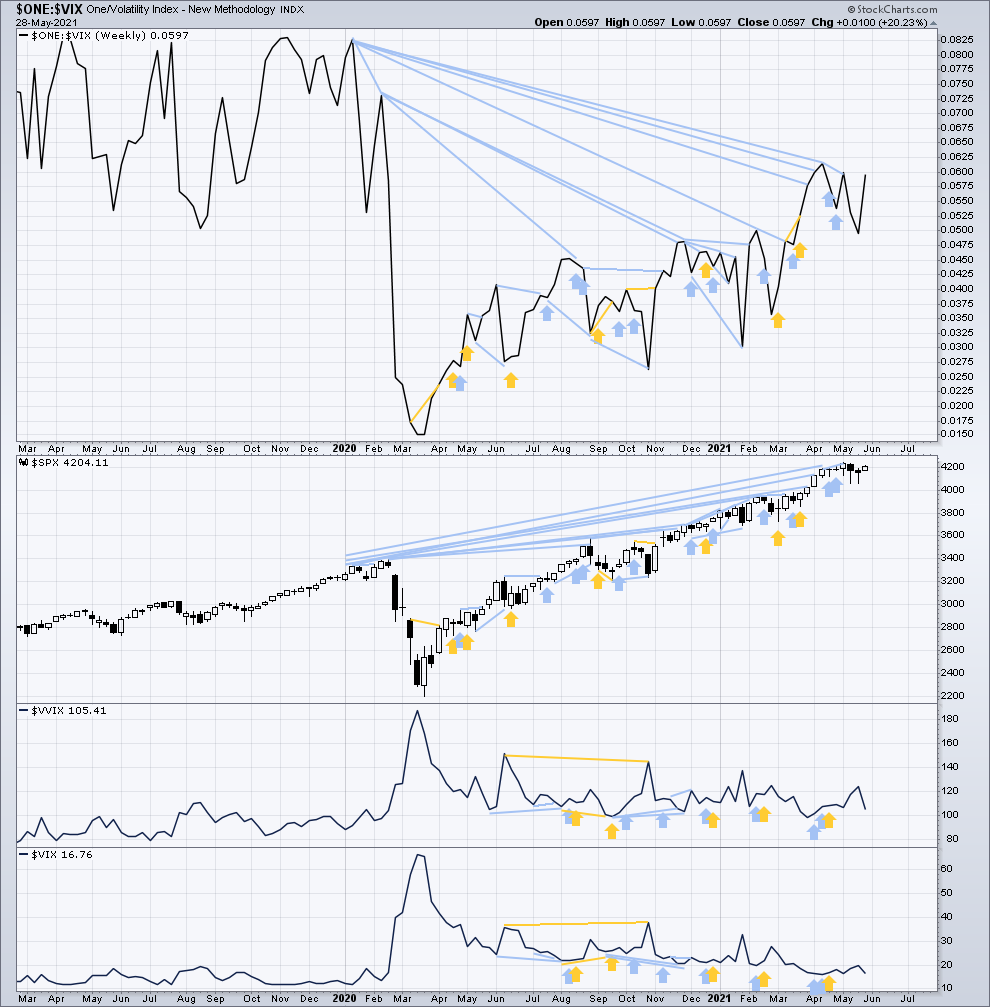
Click chart to enlarge. Chart courtesy of StockCharts.com. So that colour blind members are included, bearish signals will be noted with blue and bullish signals with yellow.
Inverted VIX remains well below all time highs. The all time high for inverted VIX was in the week beginning October 30, 2017. There is over 3 years of bearish divergence between price and inverted VIX. This bearish divergence may develop further before the bull market ends. It may be a very early indicator of an upcoming bear market, but it is not proving to be useful in timing.
This week both price and inverted VIX have moved higher. Upwards movement in price is coming with a normal corresponding decline in volatility. This supports the Elliott wave count.
Comparing VIX and VVIX at the weekly chart level:
This week both VIX and VVIX have moved lower. There is no new divergence.
DAILY CHART
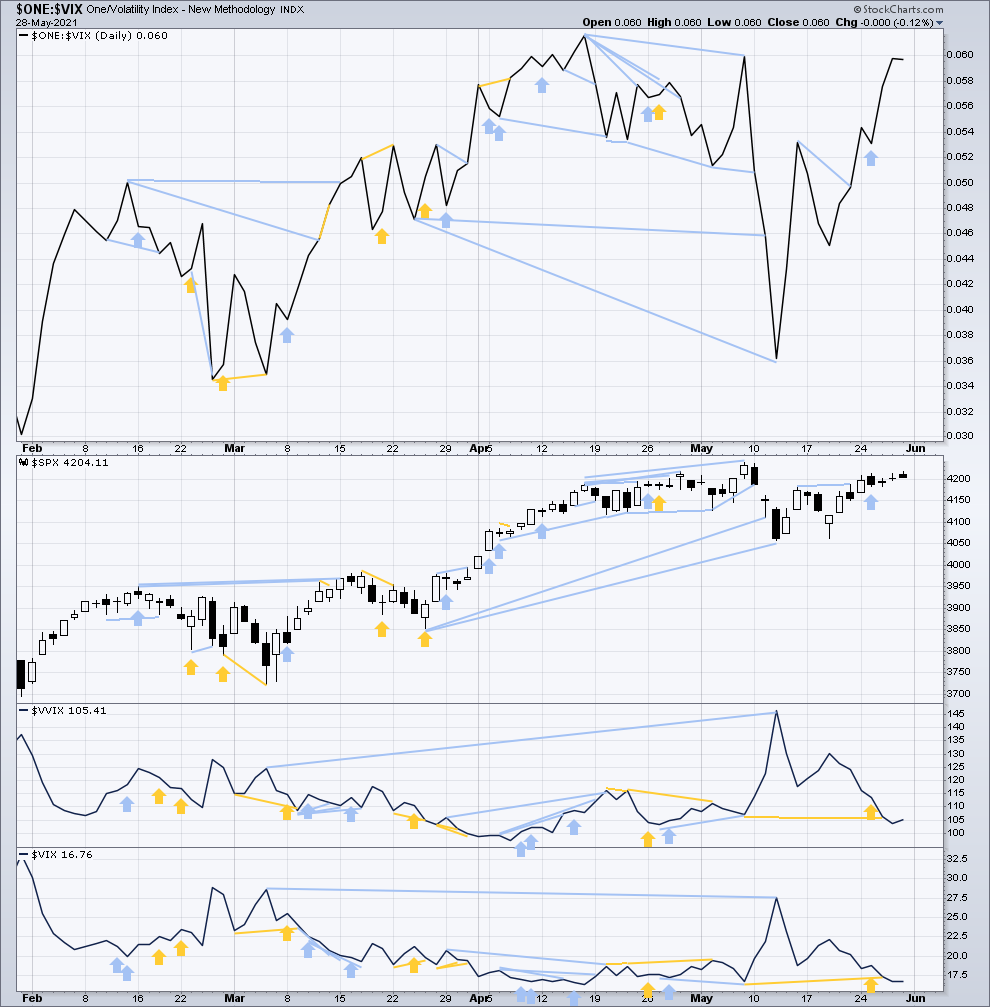
Click chart to enlarge. Chart courtesy of StockCharts.com. So that colour blind members are included, bearish signals will be noted with blue and bullish signals with yellow.
On Friday price has moved higher although the candlestick closed red. Inverted VIX is flat. This is not considered strong enough to note as divergence.
Comparing VIX and VVIX at the daily chart level:
To end the week both VIX and VVIX have moved lower. There is no new divergence.
DOW THEORY
Dow Theory confirms a new bull market with new highs made on a closing basis:
DJIA: 29,568.57 – closed above on 16th November 2020.
DJT: 11,623.58 – closed above on 7th October 2020.
Most recently, on 10th May 2021 both DJIA and DJT have made new all time highs. An ongoing bull market is again confirmed by Dow Theory.
Adding in the S&P and Nasdaq for an extended Dow Theory, confirmation of a bull market would require new highs made on a closing basis:
S&P500: 3,393.52 – closed above on 21st August 2020.
Nasdaq: 9,838.37 – closed above on June 8, 2020.
The following major swing lows would need to be seen on a closing basis for Dow Theory to confirm a change from bull to a bear market:
DJIA: 18,213.65
DJT: 6,481.20
Adding in the S&P and Nasdaq for an extended Dow Theory, confirmation of a new bear market would require new lows on a closing basis:
S&P500: 2,191.86
Nasdaq: 6,631.42
GOLD
This week overall price has moved higher, which is what last week’s analysis expected.
The Elliott wave counts remain the same.
Summary: The main wave count is bullish. A short-term target is at 1,987. The longer-term target is at 2,094 although this may need to be revised higher.
For the short term, while price remains above 1,867.82, assume the upwards trend remains in place. A new low below 1,867.82 may indicate another fourth wave correction may have begun. A sideways consolidation may then find support about the lower edge of either of the channels on the daily charts.
An alternate Elliott wave count is considered, but it has a low probability. It expects upwards movement to overall continue to a target at 1,940. The invalidation point for this alternate wave count is at 2,070.48.
Grand SuperCycle analysis and last monthly charts are here.
MAIN ELLIOTT WAVE COUNT
WEEKLY CHART
This wave count sees the the bear market complete at the last major low for Gold on 3 December 2015.
If Gold is in a new bull market, then it should begin with a five wave structure upwards on the weekly chart.
Cycle wave I fits as a five wave impulse with reasonably proportionate corrections for primary waves 2 and 4.
Cycle wave II fits as a double flat. However, within the first flat correction labelled primary wave W, this wave count needs to ignore what looks like an obvious triangle from July to September 2016 (this can be seen labelled as a triangle on the second weekly chart on prior analysis here). This movement must be labelled as a series of overlapping first and second waves. Ignoring this triangle reduces the probability of this wave count in Elliott wave terms.
Cycle wave IV may be a complete triple zigzag.
If the third zigzag of primary wave Z continues lower, then cycle wave IV may not move into cycle wave I price territory below 1,303.51.
DAILY CHART
Cycle wave IV may be a complete triple zigzag.
A target is calculated for cycle wave V.
Primary wave 1 within cycle wave V may be incomplete.
Within primary wave 1: Intermediate waves (1) and (2) may be complete, and intermediate wave (3) may only subdivide as an impulse.
A target is calculated for intermediate wave (3) that expects minor wave 5 within it to exhibit the most common Fibonacci ratio to minor wave 1.
Intermediate wave (4) may not move into intermediate wave (1) price territory below 1,739.19.
For the short term, a new low below 1,867.82 would indicate intermediate wave (3) may have been over at the last high and intermediate wave (4) may then be underway. If this happens, then intermediate wave (4) may be expected to find support at the lower edge of the redrawn acceleration channel.
ALTERNATE ELLIOTT WAVE COUNT
WEEKLY CHART
The bigger picture for this alternate Elliott wave count sees Gold as still within a bear market, in a three steps back pattern that is labelled Grand Super Cycle wave IV on monthly charts. Grand Super Cycle wave IV may be subdividing as an expanded flat pattern.
Super Cycle wave (b) within Grand Super Cycle wave IV may be a complete double zigzag. This wave count expects Super Cycle wave (c) to move price below the end of Super Cycle wave (a) at 1,046.27 to avoid a truncation and a very rare running flat. The target calculated expects a common Fibonacci ratio for Super Cycle wave (c).
Super Cycle wave (c) may have begun with a leading expanding diagonal for primary wave 1. Leading expanding diagonals in first wave positions are uncommon, so the probability of this wave count is low. However, it has a good fit and must be considered.
Second wave corrections to follow leading diagonals in first wave positions are usually very deep. Primary wave 2 may be expected to end at least about the 0.618 Fibonacci ratio at 1,920.42, and more likely a reasonable amount deeper than that. Primary wave 2 may not move beyond the start of primary wave 1 above 2,070.78.
DAILY CHART
Intermediate wave (C) may be subdividing as an impulse. Minor wave 4 within intermediate wave (C) may not move into minor wave 1 price territory below 1,757.92.
A target is now calculated for intermediate wave (C).
Minor wave 3 within intermediate wave (C) may be over at the last high. Minor wave 4 may now unfold over a few days to about two weeks. Minor wave 4 may end within the price territory of the fourth wave of one lesser degree. Minute wave iv has its price territory from 1,886.87 to 1,854.64; within this territory, the 0.236 Fibonacci ratio of minor wave 3 at 1,867.56 is a reasonable target.
TECHNICAL ANALYSIS
MONTHLY CHART

Click chart to enlarge. Chart courtesy of StockCharts.com.
With New York closed on Monday for Memorial Day, data for May is close enough to completion for analysis.
April completed an upwards month that closed as a Bullish Engulfing candlestick pattern. Importantly, however, the pattern lacked support from volume and confidence may not be had in it.
May now (almost complete) forms a strong bullish candlestick that has strong support from volume. ADX is extreme, but RSI is not overbought. There is room for this upwards trend to continue.
WEEKLY CHART
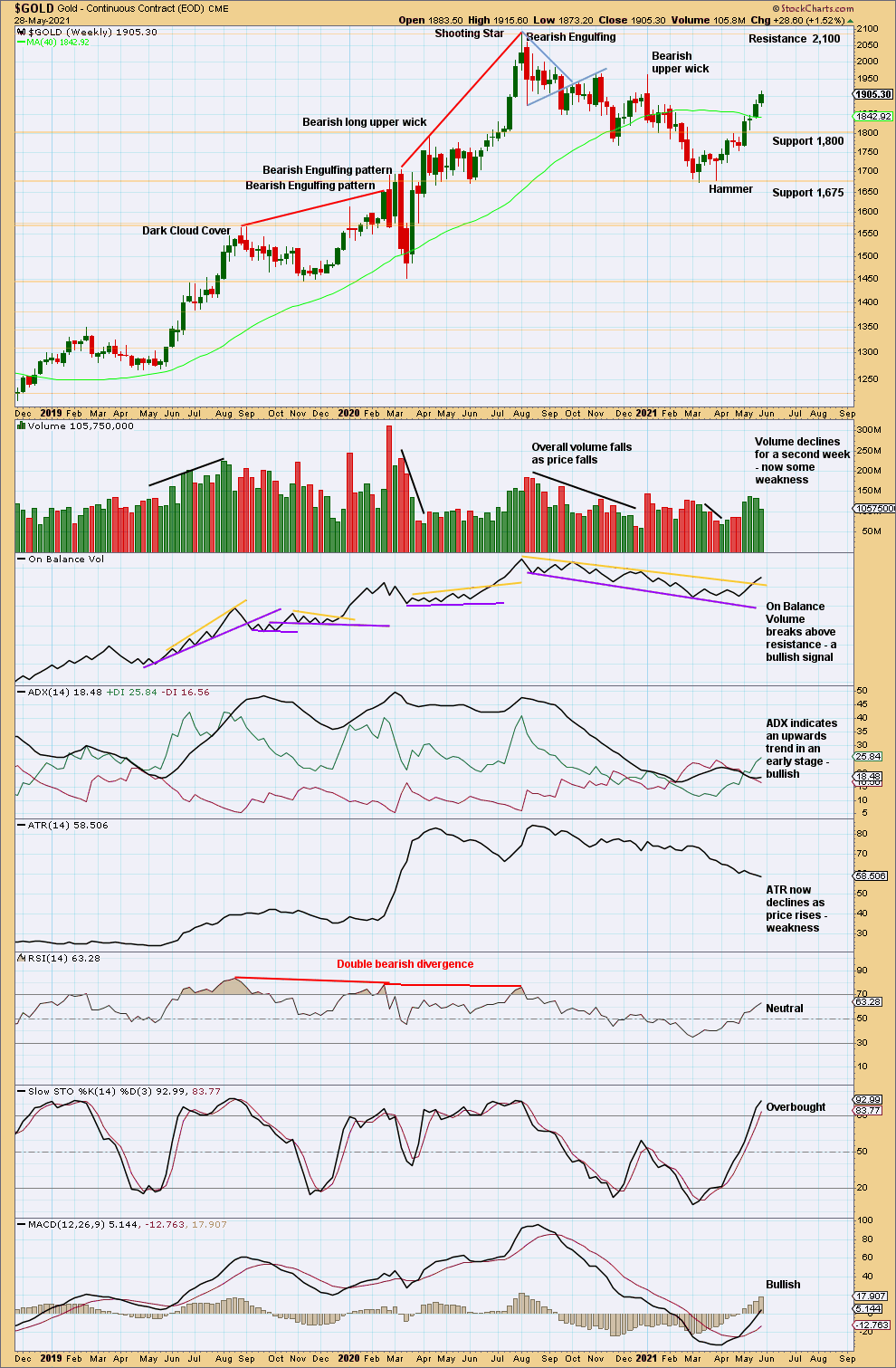
Click chart to enlarge. Chart courtesy of StockCharts.com.
There is an upwards trend now in place. However, two sessions in a row with declining volume now signal some weakness. A consolidation or pullback within the trend may occur here.
DAILY CHART

Click chart to enlarge. Chart courtesy of StockCharts.com.
The upwards trend is now very extreme and RSI is overbought. However, when Gold has a strong trend, these indicators may reach very extreme while price travels a considerable distance.
With weak volume and declining ATR while RSI is overbought and ADX is extreme, the risk here of a pullback or consolidation developing is reasonable. It looks like this is what may be happening; it may continue for a few more days to relieve extreme conditions before the trend continues.
GDX WEEKLY CHART
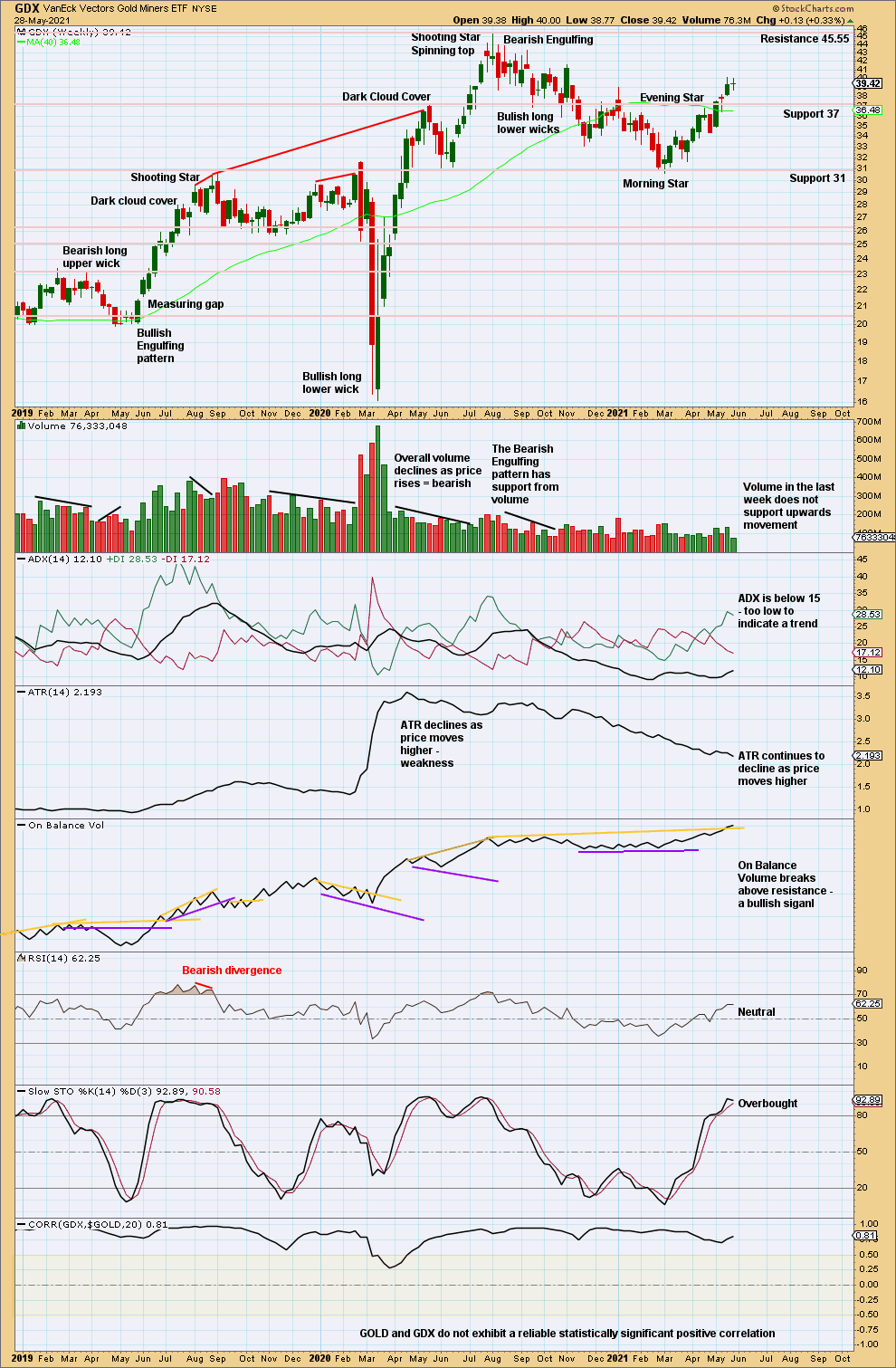
Click chart to enlarge. Chart courtesy of StockCharts.com.
Next resistance is at 45.55.
Upwards movement continues. If there is an upwards trend, then the trend would be in its very early stages; there is plenty of room for it to continue.
GDX DAILY CHART

Click chart to enlarge. Chart courtesy of StockCharts.com.
The trend is up. Next strong resistance is about 45.55.
A pennant may again be identified. Pennants are continuation patterns. A target from the flag pole is calculated at 43.59.
US OIL
Although last week completed a Bearish Engulfing candlestick pattern on the weekly chart, this week has followed with upwards movement. However, volume suggests the main Elliott wave count may still be likely.
Summary: The main Elliott wave count expects downwards movement may continue for another few weeks to a target zone at 54.86 – 56.80. Thereafter, the next target is at 46.76 if price keeps falling.
The alternate Elliott wave count expects the upwards trend may have already resumed.
The larger trend remains up.
A longer-term target for a third wave is at 87.90 or 121.43.
Oil may have found a major sustainable low in April 2020.
ELLIOTT WAVE COUNT
MONTHLY CHART
The basic Elliott wave structure is five steps forward and three steps back. This Elliott wave count expects that US Oil has completed a three steps back pattern, which began in July 2008. The Elliott wave count expects that the bear market for US Oil may now be over.
Following Super Cycle wave (II), which was a correction (three steps back), Super Cycle wave (III), which may have begun, should be five steps up when complete. Super Cycle wave (III) may last a generation and must make a new high above the end of Super Cycle wave (I) at 146.73.
A channel is drawn about Super Cycle wave (II): draw the first trend line from the start of cycle wave w to the end of cycle wave x, then place a parallel copy on the end of cycle wave w. This trend line is breached to the downside, which is a typical look for the end of a movement for a commodity.
The upper edge of the channel may provide resistance. Price is reacting down from the upper edge of this channel.
Super Cycle wave (III) may only subdivide as a five wave impulse. New trends for Oil usually start out very slowly with short first waves and deep time consuming second wave corrections. However, while this is a common tendency, it is not always seen and may not have been seen in this instance. The first reasonably sized pullback may be over already.
WEEKLY CHART
Super Cycle wave (III) must subdivide as an impulse.
Cycle wave I within Super Cycle wave (III) may be incomplete.
Within cycle wave I: Primary waves 1 and 2 may be complete, and primary wave 3, which may only subdivide as an impulse, may have begun.
Within primary wave 3: Intermediate wave (1) may be complete, and intermediate wave (2) may still be unfolding. Intermediate wave (2) may not move beyond the start of intermediate wave (1) below 33.65.
This week two charts are given at the daily chart level for intermediate wave (2).
MAIN DAILY CHART
Intermediate wave (2) would most likely subdivide as a zigzag. Minor wave A within the zigzag may be a complete impulse. Minor wave B may have continued higher as a double zigzag. If minor wave A is correctly labelled as a five wave impulse, then minor wave B may not move beyond its start above 67.97. This first wave count labels minor wave A as a five; this has the best fit and look, so it has the highest probability.
Minor wave C may now continue lower for a few weeks. It must subdivide as a motive structure, most likely an impulse.
Intermediate wave (2) may last for several weeks.
As price approaches the first target zone at 54.86 to 56.80, and if then the structure is complete and technical analysis indicates a low may be in place, then it may end there. But if price keeps falling and / or the structure of intermediate wave (2) is incomplete, then the 0.618 Fibonacci ratio at 46.76 would be the next target.
Labelling within intermediate wave (2) may still change as it unfolds and alternate wave counts for the short-term structure may need to be considered. There are several different structures that intermediate wave (2) may unfold as.
Intermediate wave (2) may not move beyond the start of intermediate wave (1) below 33.65.
FIRST ALTERNATE DAILY CHART
This week this alternate wave count is new.
This wave count must see the downwards wave ending on 23rd of March as a three, but this movement looks best as a five. This reduces the probability of this wave count.
If the downwards wave labelled minor wave A may be seen as either a three or a five, then both structures must be considered. If minor wave A within intermediate wave (2) subdivides as a three, then intermediate wave (2) may be subdividing as a flat.
Within a flat the common range for minor wave B would be from 67.97 to 72.04. Minor wave B may make a new high beyond the start of minor wave A, as in an expanded flat. If minor wave B is complete at this week’s high, then intermediate wave (2) may be unfolding as a regular flat.
Minor wave C would be likely to make at least a slight new low below the end of minor wave A at 57.26 to avoid a truncation.
The target is the same for both this first alternate wave count and the main wave count.
SECOND ALTERNATE DAILY CHART
It is possible that intermediate wave (2) is over as a brief and shallow zigzag.
This wave count must see the downwards wave ending on 23rd of March as a three, but this movement looks best as a five. This reduces the probability of this wave count.
If intermediate wave (3) has begun, then minor wave 1 within it may be a complete leading expanding diagonal. Leading expanding diagonals are less common than impulses. This further reduces the probability of this wave count.
Minute wave ii within minor wave 3 may not move beyond the start of minute wave i below 60.62.
THIRD ALTERNATE WEEKLY CHART
This third alternate wave count considers the possibility that primary wave 3 may have been over at the last high.
Primary wave 3 is close to equal in length with primary wave 1; it is 0.79 longer than primary wave 1.
Primary wave 4 may be continuing as a zigzag, flat, triangle or combination. The daily charts for this alternate wave count would look the same as the three daily charts above, the degree of labelling would be one degree higher.
TECHNICAL ANALYSIS
WEEKLY CHART
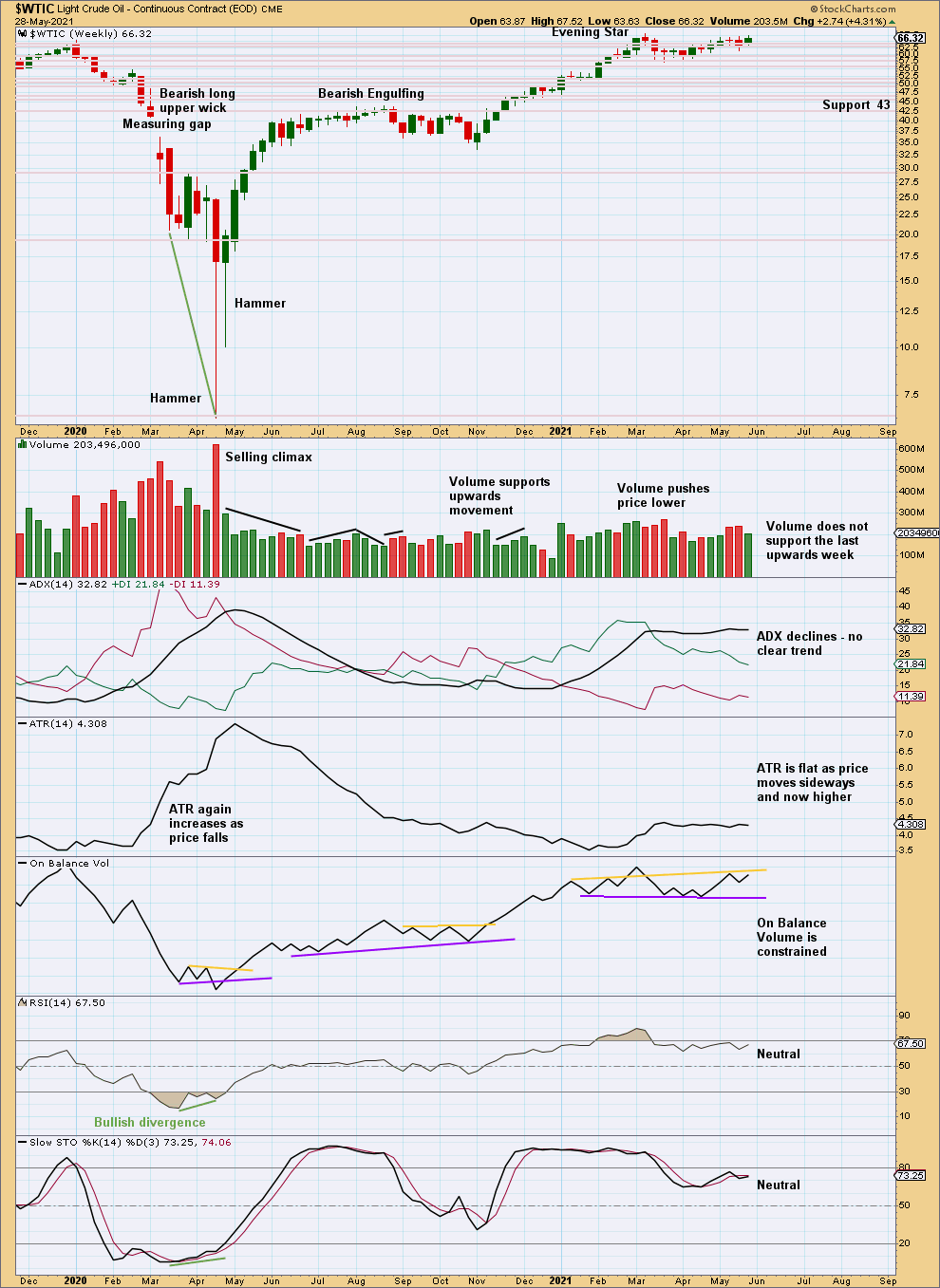
Click chart to enlarge. Chart courtesy of StockCharts.com.
The Bearish Engulfing pattern has been followed by an upwards week, which negates the pattern. However, this week volume has not supported upwards movement. Weak volume and resistance for both price and On Balance Volume this week support the main daily and first daily alternate charts.
DAILY CHART
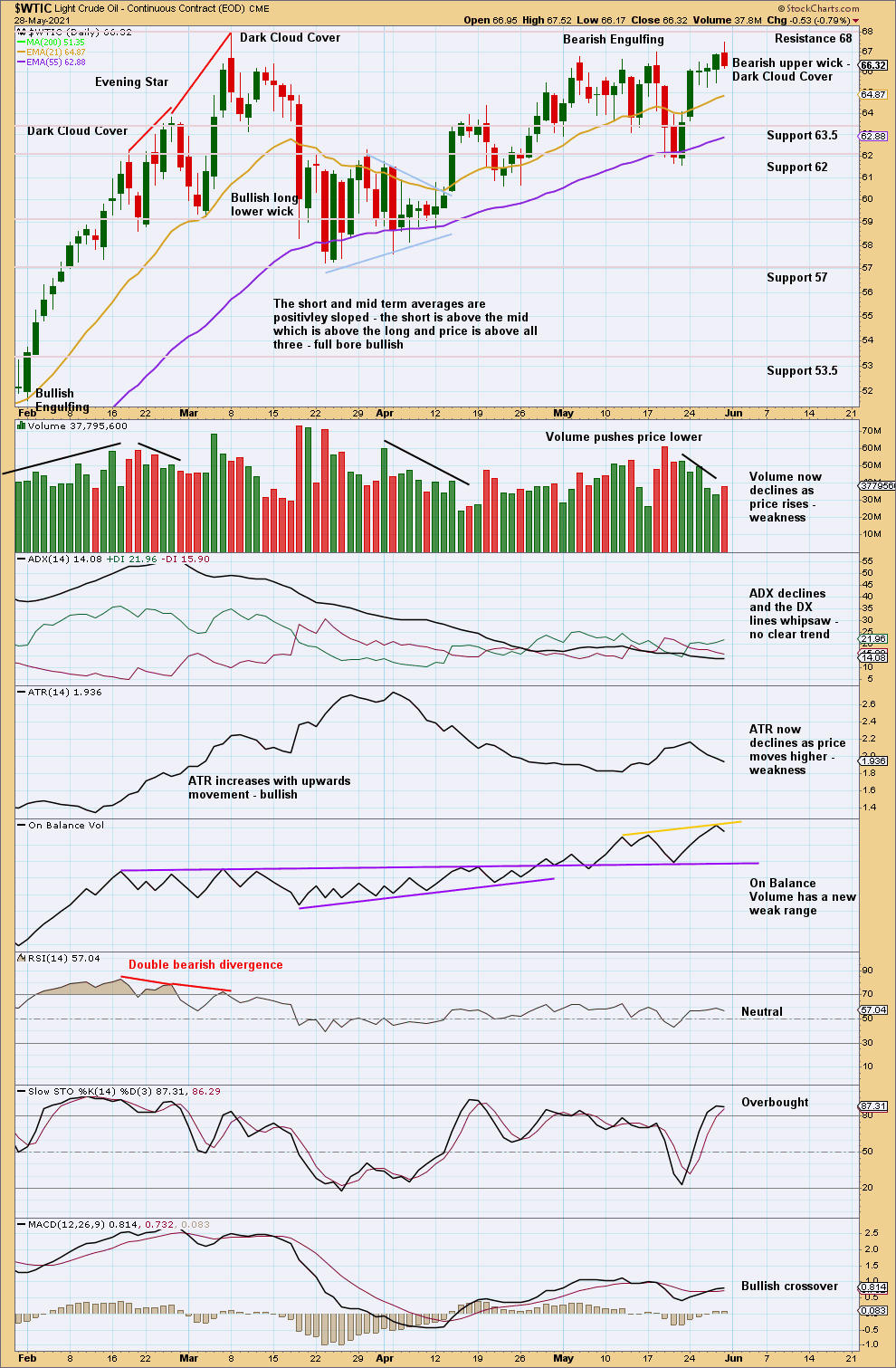
Click chart to enlarge. Chart courtesy of StockCharts.com.
There is no clear trend. Price is consolidating with resistance about 68 and support about 57. At this stage, an upwards swing may be complete here or very soon. A downwards swing to support may now be expected. This is the general outline for the main daily and first alternate daily Elliott wave counts.
A break above resistance with a close above 68 on an upwards day with support from volume would be required for the bullish case.
—
Always practice good risk management as the most important aspect of trading. Always trade with stops and invest only 1-5% of equity on any one trade. Failure to manage risk is the most common mistake new traders make.
—

